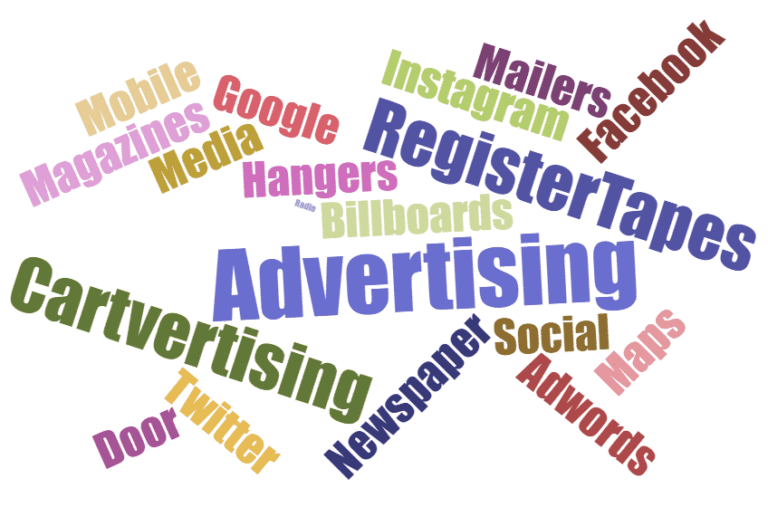What’s the Best Way to Advertise a Small Business?
Every small business is unique. While we are a bit biased and believe our advertising is the first, best way to advertise for all small businesses, we also believe that every business owner should explore the best way to advertise for themselves. To help you evaluate your options, we’ve created this 6 step guide to walk you through the easy work of identifying which advertising methods are best and which are bust!
Step 1: Define Advertising Success
How will you know if something is the “best way to advertise” if you don’t know what successful advertising looks like?
Some common ways you might evaluate ad campaigns are by brand awareness, website visits, or lead generation. These are all positive things, but at the end of the day, your advertising should generate a profit.
Let’s say you spend $500 on Google Ads and increase your website visitors from 200 to 1000 per month. If your profits don’t increase from that effort, then your advertising has not been successful.
We don’t say this to sound harsh. Rather, setting firm expectations for what your advertising should do is the first step to choosing the most effective advertising campaigns.
[bctt tweet=”The purpose of advertising is to increase profits. ” username=”IndoorMediaAds”]
To measure the success of your ad campaign, a simple formula to follow is:
Average Sale X Total New Customers = Sales Revenue generated from promotions
– Cost of Goods Sold
– Discount Given to Consumer (if running a coupon ad)
– Advertising Spend
= Profit generated from your advertising campaign.
Step 2: Identify Your Business Objective
If your business is about building trust, credibility, and a recognizable name (think Lawyer, Realtor, or Dentist), brand advertising that reinforces those messages will work best for generating new customers over time.
On the other hand, businesses like a Dry Cleaner, Auto Shop, or Restaurant can greatly benefit from direct-response advertising that sparks a customer to try a new vendor in the spur of the moment.
Branding Ads are About Familiarity
The message of a branding ad could be the literal brand itself, such as a huge sign with a Coke can on it. It could be education pieces, making consumers aware of challenges or needs they may not know they have. Or, the message can even be just a slogan:

Ultimately, branding ads are not likely to generate a sale immediately after the prospect sees it. When you see a gigantic running shoe as you are zooming down the highway, you don’t swerve off the road in pursuit of a new pair of kicks. Instead, when you are sitting at the store and looking at a stack of Nike shoes next to a bunch of other shoes, you relive the feelings the ad conjured: that you too could be one of those super fit, super sexy models, and all you have to do is shell out $100 for a pair of sneakers.
Brand advertising can do more than just convey the actual message of the ad itself. They can convey your market position simply by being there. For example, you enter a neighborhood and see four homes for sale all with the same realtor. Then, you go to the grocery store and see that same realtor has an ad on the shopping carts. Finally, when you Google “homes for sale in Houston, TX” the realtor appears again. Together, these ads generate an image of market leadership, and that can be done at the local (neighborhood), regional, state, or national level.
Direct Response Ads Command Action
Direct-Response ads command action and ask the viewer to get off their duff and do something. For example, a coupon. The action (buy something) and the reward (get something free or cheaper) are explicit.
Buy One, Get One Free! (BOGO!)
Other kinds of actions are “call now”, “visit our website”, “complete this form”, and more. The benefit of direct-response advertising is that when your prospect is in the decision phase of the buyer’s journey, it may be just the thing to get them to pull the trigger with your business. On the other hand, ordering people about when they don’t trust you can be a real turn off. For those businesses that have a very short sales cycle, Direct Response advertising may be the only type of ad they need.
Additionally, Direct Response advertising can provide some in-depth metrics about how your ad is functioning. This is the basis for a lot of digital and coupon advertising.
Step 3: Identify Your Target Audience
No matter what kind of small business you own, or where you’re located, I can tell you that targeting a local audience is the best way to advertise. And I don’t just mean in your city or surrounding zip codes, I mean hyper-locally. Find your business on a map, draw a 5-mile radius around it, and boom! There is your target audience.
Why should your small business advertise locally? Because your customers likely live within just a few miles of where your business is located.
Have you ever driven 10 miles to go to the dry cleaner? Or worked with a realtor from the other side of town?
Consumers tend to stick close to home, so that is exactly who your advertising should target.
Step 4: Choose Advertising That is Consistent
Your customer list will naturally grow and shrink. First, you gain one, then you lose one. This natural ebb and flow of customer growth means that your advertising should be done consistently and frequently.
Think of your business as a bucket poked with holes being filled with water.
Advertising is the faucet. When turned on, you get a constant stream of new prospects flowing into your customer acquisition pipeline. As you pour more water into the bucket, some of it naturally spills out. That’s okay! If you keep adding water to the bucket, you’ll always have a steady stream of prospects.
If you turn the faucet off, you run the risk of your bucket running dry. Life can be unpredictable. So while you may feel that you’ve mastered the ability to turn your faucet on and off at just the right moments, any unexpected bump in the road might cause your bucket to empty.
We want your business to thrive! Consistent advertising can make that a reality.
Step 5: Research Types of Small Business Advertising
A quick Google search for “types of small business advertising” returns over 900 million results!
If you’re like most small business owners I know, sorting through the vastness of the internet takes time that you don’t have. Instead, check out these posts to quickly learn about the types of advertising that are most effective for small businesses.
- Word of Mouth
- Traditional Print and Broadcast Media
- Newspaper
- Radio
- Direct Mail
- TV
- Online Advertising
- Local Listings
- Reputation Management
- Google Adwords
- Paid Social Media Ads
- Grocery Store Advertising
- Receipt Tape Coupons
- Shopping Cart Ads
Step 6: Compare Your Options
By this point, you’ll be familiar with the major types of advertising available, and have a general idea of which ones meet your criteria:
- Generate Profit
- Match your business objective
- Reach your target audience
- Are distributed repetitively
Now what?
To find the best way to advertise, you need to rank those options through an even comparison. To do this, look at all of your above criteria, compare across each advertising medium.
We call this method of comparison “RATE Your Advertising”.
To read the full instructions (and get a downloadable worksheet) read this blog post.
Whichever type of advertising has the highest mix for the lowest cost is the best way to advertise your small business!



